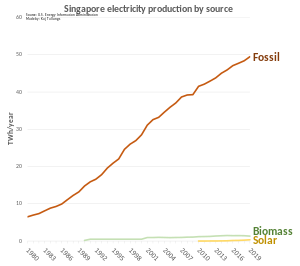This article may need to be rewritten to comply with Wikipedia's quality standards. (February 2023) |
Total energy supply 2021[1]
Energy in Singapore is critically influenced by its strategic position in maritime Southeast Asia, nestled between Malaysia and the Singapore Strait, near essential maritime routes like the Straits of Malacca and the South China Sea. This location has established Singapore as a central hub for the global petroleum, petrochemical, and chemical industries, with Jurong Island serving as a key base for over 100 international companies in these sectors. The majority of Singapore's energy consumption is derived from petroleum and other liquids, accounting for 86% of its total energy use, while natural gas represents 13%, and coal and renewable resources make up the remaining 1%.[2]
Energy in Singapore has evolved in response to its environmental impact and reliance on fossil fuels. The government has implemented several strategies to transition towards a more sustainable energy model. In 2019, Singapore introduced the Carbon Pricing Act, aimed at reducing carbon emissions by imposing a tax on greenhouse gas emissions. Concurrently, the Energy Market Authority launched the "4 Switches" strategy, which focuses on enhancing energy efficiency, increasing the adoption of renewable energy sources, and integrating advanced technologies such as carbon capture and storage.[2]

In addition to legislative measures, the Singapore Green Plan has been developed to set forth clear objectives for environmental improvement and sustainability. This plan includes initiatives to expand green spaces, phase out new registrations of diesel vehicles by 2025, significantly expand the electric vehicle charging infrastructure, and increase the deployment of solar energy to 2 gigawatts by 2030.[2]
Furthermore, in terms of energy policy, Singapore has set ambitious targets aimed at enhancing energy efficiency and reducing its environmental impact. By 2030, the country plans to improve its energy efficiency by 36% compared to levels in 2005. Supporting measures have included implementing energy efficiency standards and introducing labeling for lamps in 2015. Additionally, Singapore is working to increase its solar photovoltaic (PV) capacity and aims to reduce greenhouse gas emissions by 16% below what they would be in 2020, with emissions expected to peak by 2030.[2][3]
- ^ "Singapore - Countries & Regions". IEA. Retrieved 6 June 2024.
- ^ a b c d "International - U.S. Energy Information Administration (EIA)". www.eia.gov. Retrieved 5 June 2024.
- ^ "Singapore - Countries & Regions". IEA. Retrieved 6 June 2024.
© MMXXIII Rich X Search. We shall prevail. All rights reserved. Rich X Search
